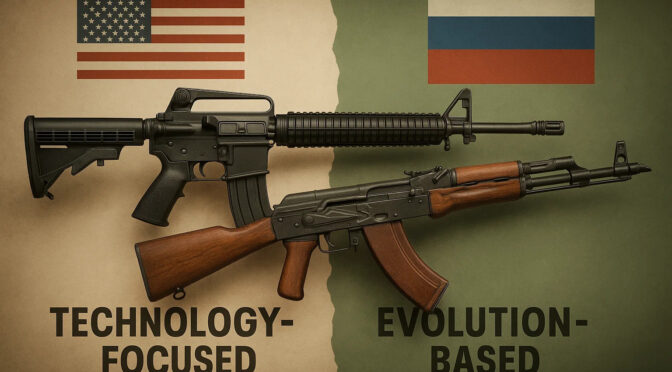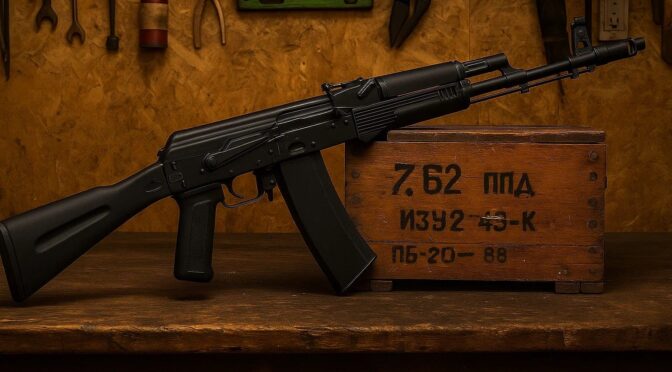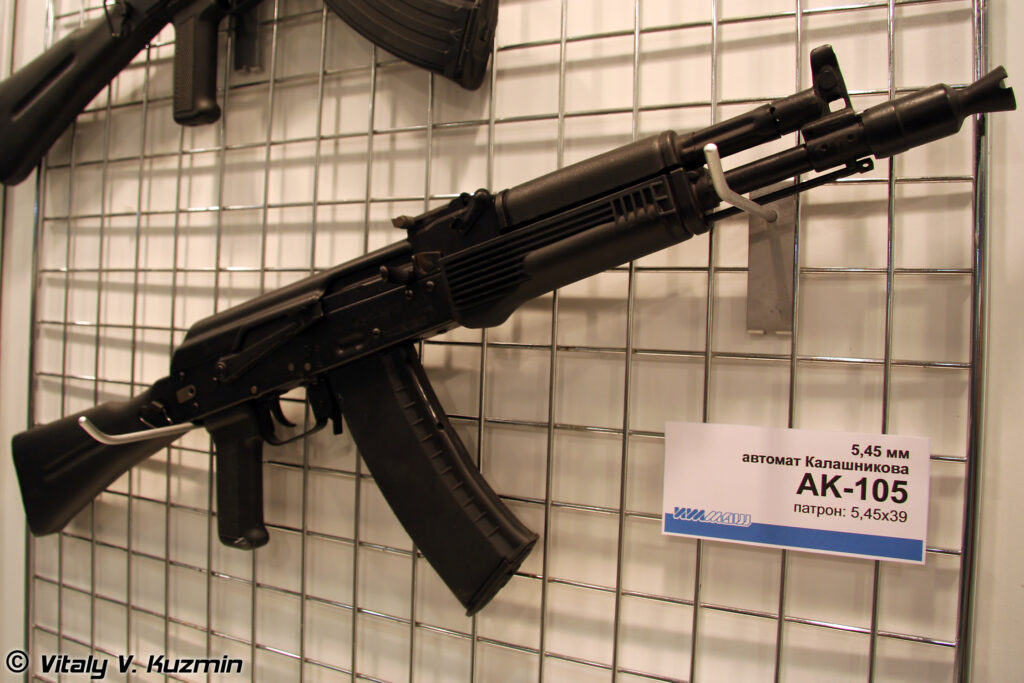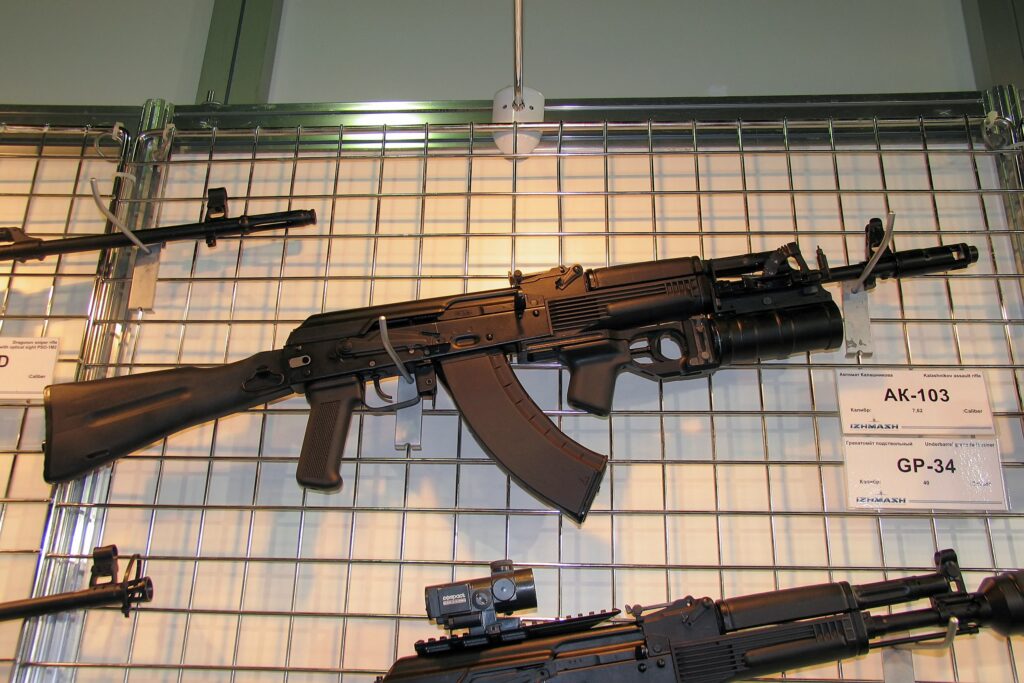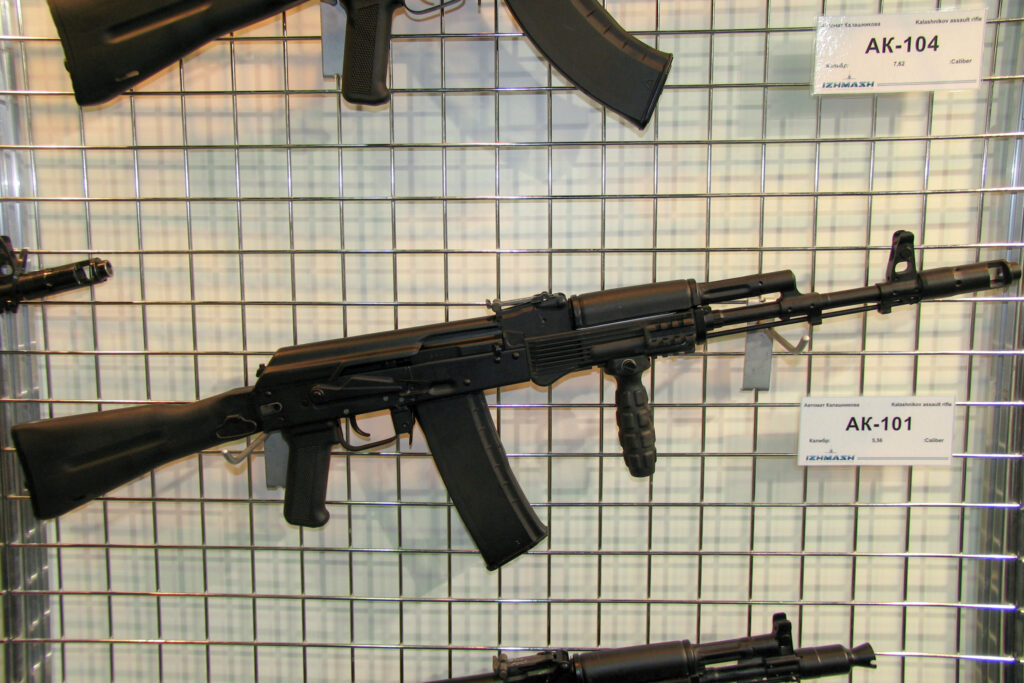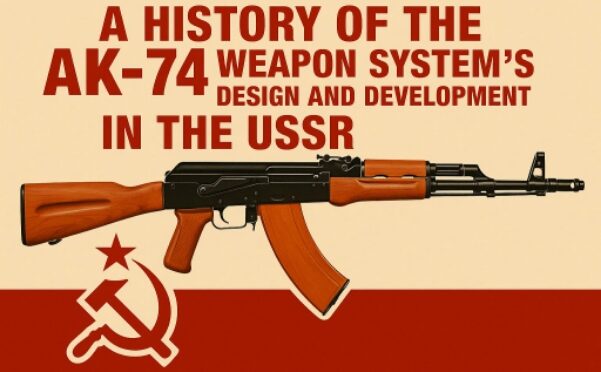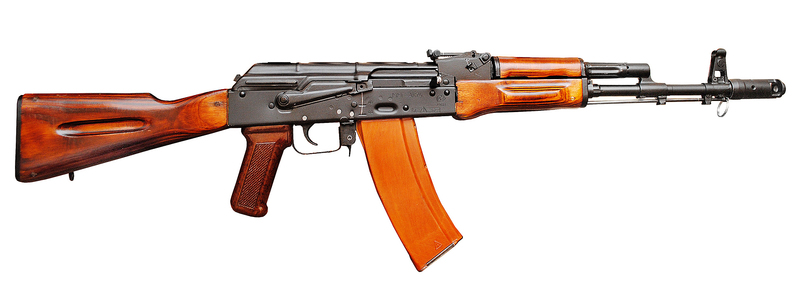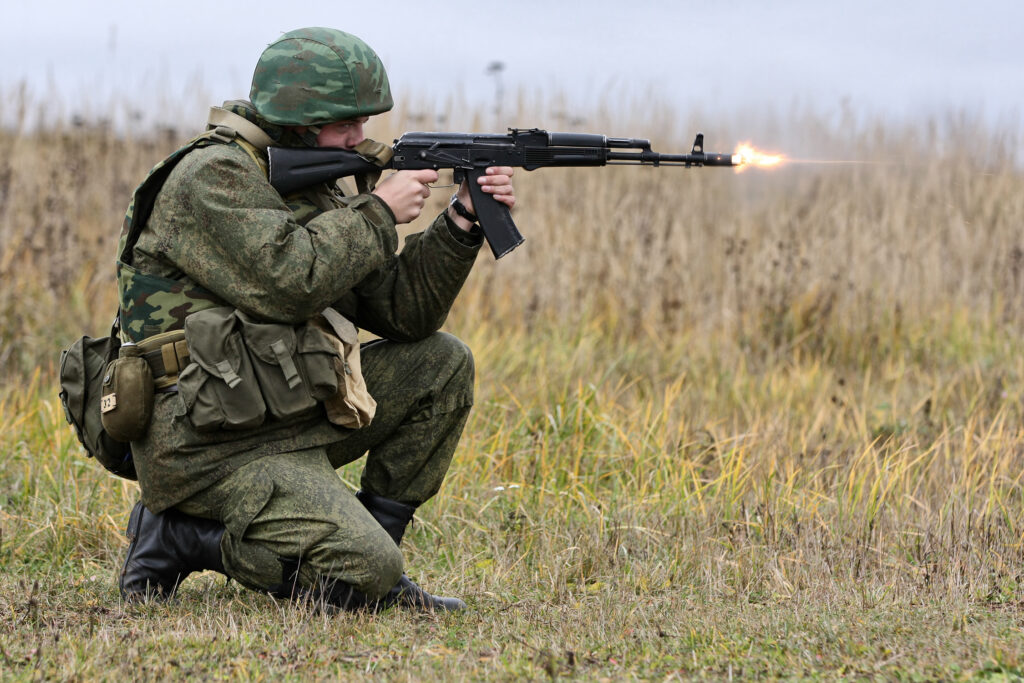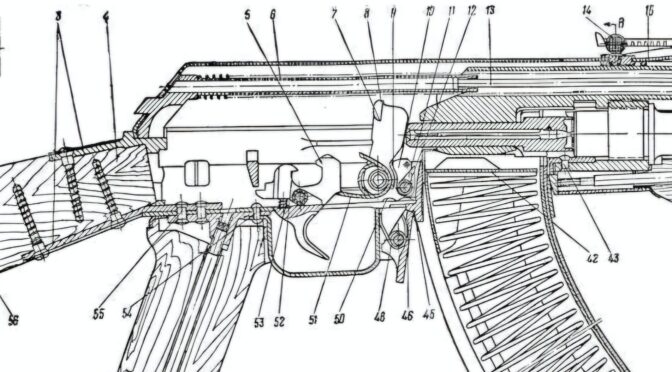The history of Soviet and, subsequently, Russian small arms development over the past century is often dominated by the towering success of the Kalashnikov platform. However, to fully comprehend the reasons for the AK’s enduring dominance, one must study not only its triumphs but also the numerous ambitious, innovative, and sometimes bizarre projects that failed to supplant it. These failures, far from being mere historical footnotes, are crucial for understanding the foundational philosophy that has guided Soviet and Russian weapons procurement for generations. This philosophy can be best described as the “Doctrine of Sufficient Excellence.”
Forged in the crucible of the Second World War and solidified during the Cold War, this doctrine is not a formal written mandate but an ingrained institutional mindset. It prioritizes a specific hierarchy of characteristics for a general-issue infantry weapon. At the apex is absolute reliability under the most adverse conditions imaginable—mud, sand, ice, and neglect.1 Following closely are simplicity of operation, enabling a vast, conscript-based army to achieve basic proficiency with minimal training, and ease of mass production, allowing for rapid armament and replacement during a large-scale conflict.1 Ergonomic refinement, modularity, and even exceptional accuracy, while desirable, are considered secondary attributes. A weapon is deemed “sufficiently excellent” when it perfectly fulfills these primary requirements, even if it is surpassed by competitors in other metrics.
This report will analyze a selection of key Soviet and Russian small arms projects that are considered failures. A project is categorized as a “failure” not necessarily because it was a technically deficient weapon in isolation, but because it violated one or more of the core tenets of this doctrine without offering a sufficiently compelling, game-changing advantage to justify the deviation. Through an examination of these case studies, we will explore projects that were too complex for their time, too radical for their military culture, too expensive for their economy, or doctrinally misaligned with the realities of the Soviet and Russian way of war.
Part I: The Pre-Kalashnikov Era – Forging a Doctrine in Steel and Fire
Before the Kalashnikov became the defining symbol of Soviet military might, the Red Army’s small arms development was characterized by ambitious experimentation. This period produced some of the world’s first examples of modern weapon concepts, but it also provided harsh, formative lessons that would directly shape the stringent requirements for all future infantry arms.
Case Study: The AVS-36 Automatic Rifle
The Avtomaticheskaya Vintovka Simonova obraztsa 1936 goda (AVS-36) stands as a landmark of firearms history, being one of the world’s first select-fire infantry rifles to be formally adopted for military service.3 Designed by Sergei Simonov, it represented a technologically bold leap for the Red Army in the 1930s, promising to equip the individual soldier with the firepower of a machine gun in the form of a standard rifle. However, its service life would prove to be a brief and cautionary tale.
Technical Flaws
The AVS-36 was a gas-operated rifle chambered in the powerful 7.62x54mmR cartridge. Its ambition was matched only by its mechanical complexity. The operating mechanism was intricate, utilizing a short piston stroke and a vertically sliding locking block that was highly susceptible to fouling.3 The very construction of the rifle, with its numerous openings and moving parts, was an invitation for dirt and debris to enter the action, a critical flaw for a weapon intended for frontline infantry use.3 Russian sources note that the rifle suffered from a fragile receiver and a problematic bolt group, further compromising its field-worthiness.4 It was also notoriously “fickle” regarding ammunition quality, a significant liability for an army that prioritized logistical simplicity.3
Operational Failure (The Winter War)
The AVS-36’s baptism by fire came during the Soviet-Japanese border conflicts and, most significantly, the 1939-1940 Winter War against Finland. It was in the brutal, sub-zero conditions of the Karelian Isthmus that the rifle’s design deficiencies became catastrophically apparent. Many rifles were shipped to the front still coated in their thick, cosmoline-like storage grease. In the extreme cold, this grease “froze” solid, rendering the complex actions of the rifles completely inoperable.3 This single issue, born of a combination of poor logistical preparation and a design intolerant of such neglect, crippled the weapon’s effectiveness.
Furthermore, while the rifle’s large muzzle brake was quite effective at mitigating muzzle climb, the sheer, intense recoil impulse of the full-power 7.62x54mmR cartridge made automatic fire wildly impractical.3 The weapon was virtually uncontrollable in full-auto, negating its primary conceptual advantage over bolt-action and semi-automatic rifles. The intended doctrine of using automatic fire to repulse sudden attacks was largely a fantasy, as soldiers could not keep their sights on target.5
Political and Logistical Demise
The AVS-36’s poor performance did not go unnoticed. A competing design by Fedor Tokarev, the SVT-38, was also adopted and, while not without its own initial flaws, was considered a sturdier and more reliable weapon.3 A politicized dispute arose within the Soviet elite, and Simonov’s design, seen as lighter but more fragile, lost out.3 Production of the AVS-36 was terminated in 1940 after a run of approximately 35,000 to 65,000 units, and the rifle was rapidly withdrawn from service, with many captured examples being used by Finnish forces.3
The failure of the AVS-36 was a pivotal moment in the formation of Soviet small arms doctrine. It was a brutal, real-world lesson that advanced features and theoretical advantages are utterly worthless if they come at the expense of fundamental reliability in the hands of a conscript soldier under the worst possible conditions. The Red Army’s experience in Finland, where the simple, crude, but utterly dependable PPSh-41 submachine gun proved devastatingly effective, stood in stark contrast to the failure of the complex AVS-36. The Soviet command learned that the ideal infantry weapon was not the one with the most features, but the one that always worked. This experience directly shaped the non-negotiable requirements for simplicity and reliability in the post-war trials that would ultimately produce the AK-47. The AVS-36 had to fail so the Kalashnikov could succeed.
Part II: The Shadow of the AK – Challenging an Icon
Following the adoption of the AK-47, Soviet small arms design entered a new era. The Kalashnikov was not just a rifle; it was the physical embodiment of the Doctrine of Sufficient Excellence. It became the benchmark against which all future designs would be judged. Any potential replacement would not only have to be better, but so overwhelmingly superior that it could justify the monumental cost of replacing an entire, established ecosystem.
Case Study: The TKB-517 – The Technically Superior Contender
In the mid-1950s, the Soviet military initiated a competition to find a replacement for the original milled-receiver AK-47. The primary objectives were to develop a weapon that was cheaper and faster to produce using modern stamped-steel manufacturing techniques, and to improve upon the AK-47’s notoriously poor controllability during automatic fire.6 The two main finalists in this contest were Mikhail Kalashnikov’s modernized prototype, which would become the AKM, and a highly refined rifle from the Tula design bureau, the TKB-517, designed by the brilliant German A. Korobov.6
Technical Analysis
Externally, the TKB-517 bore a strong resemblance to the Kalashnikov, featuring a similar layout and construction from stamped steel with wood furniture.7 Internally, however, it was a completely different machine. Instead of the AK’s robust and simple long-stroke gas piston and rotating bolt, Korobov employed a sophisticated lever-delayed blowback mechanism based on the principles pioneered by Pál Király.7 This system used mechanical leverage to delay the rearward motion of the bolt, allowing chamber pressure to drop to safe levels before extraction. This method of operation offered several potential advantages, including a smoother recoil impulse and the elimination of the violent impacts characteristic of the AK’s gas system.
Performance in Trials
During extensive competitive trials, the TKB-517 demonstrated clear superiority over the Kalashnikov prototype in several key performance areas. Multiple sources, including Russian-language publications, confirm that Korobov’s rifle was significantly more accurate and controllable, especially during full-automatic fire.7 One report from the 1955 trials explicitly states that even poorly trained soldiers, firing in bursts from a supported position, achieved better results with the TKB-517 than with the proto-AKM.10 Furthermore, the TKB-517 was found to be more reliable, particularly in fine sand conditions where the AK’s open gas system was more vulnerable, and was also lighter and simpler (and therefore cheaper) to manufacture.7 By most objective metrics of the competition, the TKB-517 was the better rifle. One Russian source bluntly states that the AKM was “losing the competition”.10
Reasons for Rejection
Despite its demonstrated superiority, the TKB-517 was not selected. The decision was not based on a failure of the weapon itself, but on powerful institutional and logistical factors. The official justification cited the Soviet military’s existing familiarity and “greater proficiency” with the Kalashnikov’s manual of arms and operating system.7 The selection committee, faced with a choice between a superior but novel design and an evolutionary improvement of a known and trusted system, chose the latter.10 While a potential technical concern may have been the higher extraction pressure common to lever-delayed actions, the primary driver was institutional conservatism and logistical pragmatism.7
The rejection of the TKB-517 is the quintessential example of “procurement inertia.” The failure was not one of engineering, but of the rifle’s inability to overcome the immense industrial, training, and logistical ecosystem already built around the Kalashnikov. The Soviet Union had already invested heavily in the AK platform. Millions of soldiers were trained on its operation and maintenance. Armorers across the armed forces were experts in its service. Factories were tooled for its specific manufacturing processes. Adopting the TKB-517 would have necessitated a complete and costly overhaul of this entire system: new factory tooling, new training manuals and curricula for every soldier and armorer, and a completely separate supply chain for spare parts. The performance advantages offered by Korobov’s rifle, while real, were simply not great enough to justify the astronomical economic and logistical cost of replacing the entire, entrenched Kalashnikov ecosystem. The Soviet system chose the “good enough” evolutionary step (the AKM) over the “better” revolutionary one because the former was exponentially cheaper, faster, and less disruptive to implement on a national scale. This decision cemented the Kalashnikov’s dominance for decades to come.
Table 1: Comparative Performance Metrics: AKM vs. TKB-517 (c. 1955 Trials)
| Feature | TKB-517 (Korobov) | AKM (Kalashnikov Prototype) |
| Action Type | Lever-Delayed Blowback | Gas-Operated, Rotating Bolt |
| Caliber | 7.62×39mm | 7.62×39mm |
| Weight (Unloaded) | 3.18 kg 7 | Heavier than TKB-517 |
| Length | 910 mm 7 | Similar to TKB-517 |
| Barrel Length | 415 mm 7 | 415 mm |
| Rate of Fire | 560 rounds/min 7 | ~600 rounds/min |
| Accuracy (Trials) | Superior to AKM, especially in full-auto 7 | Inferior to TKB-517 10 |
| Reliability (Trials) | Superior to AKM, especially in sand 7 | Met requirements, but less reliable than TKB-517 12 |
| Production Method | Stamped Steel | Stamped Steel |
| Production Cost | Lower than AKM 9 | Higher than TKB-517 9 |
Part III: The Avant-Garde – When Innovation Outpaces Doctrine
While the mainstream of Soviet arms development flowed conservatively down the path of the Kalashnikov, there were powerful undercurrents of radical innovation. Designers, often working in the relative obscurity of state design bureaus, explored concepts that were decades ahead of their time. These projects, while engineering marvels, almost invariably failed to gain traction, crashing against the rigid wall of Soviet military doctrine and technological readiness.
Case Study: German Korobov and the Bullpup Heresy (TKB-022PM)
German A. Korobov was perhaps the most prolific and visionary of the Soviet Union’s “unknown” weapons designers.14 While none of his designs were ever adopted for mass production, his work consistently pushed the boundaries of conventional firearm engineering.11 His TKB-022PM series of assault rifles, developed in the 1960s as a potential competitor to the AKM, was his most radical and perhaps most brilliant creation.18
Radical Design
The TKB-022PM was a bullpup rifle, a configuration that places the action and magazine behind the trigger group to achieve a shorter overall weapon length without sacrificing barrel length.19 This was already a novel concept for the time, but Korobov’s design went much further. It utilized a vertically moving breechblock and an annular gas piston that encircled the barrel, allowing for an incredibly compact receiver group.18
Its most revolutionary feature, however, was its forward ejection system. A U-shaped rammer/extractor would chamber a round, and after firing, would pull the spent casing back and then push it forward and up into an ejection tube running parallel to and above the barrel. The casing would then exit from a port near the muzzle.18 This ingenious solution completely solved the primary drawback of most bullpup designs—the ejection of hot brass into the face of a left-handed shooter—making the TKB-022PM truly and effortlessly ambidextrous.18 This design gave the TKB-022PM the best barrel-length-to-overall-length ratio of any assault rifle of its era.18
Performance
The rifle’s performance in trials was exceptional. Firing from unstable positions, it demonstrated three times better accuracy than the standard-issue AKM.18 It was also remarkably light, with some variants weighing as little as
2.34 kg, thanks to its extensive use of Bakelite, an early polymer, for its housing.18
Reasons for Rejection
Despite its stellar performance, the TKB-022PM was rejected by the Soviet army for being “too radical”.18 The military establishment, deeply conservative in its approach to infantry weapons, was unwilling to embrace such a dramatic departure from the conventional layout of the Kalashnikov. Specific concerns were raised about the unfamiliar rearward balance of the bullpup design, and, critically, the long-term durability of the plastic housing under the harsh conditions of Soviet military service or during decades of strategic storage.18 One Russian source also suggests a more pragmatic reason for its rejection: at the time, small arms were considered an auxiliary component of the Soviet war machine, and the leadership decided that development funds were better spent on higher-priority systems like missiles and tanks.25
Case Study: The VAG-73 Caseless Pistol – A Technological Mirage
In 1973, a self-taught engineer named Vladimir Gerasimenko presented the authorities with a unique and ambitious project: the VAG-73, a select-fire machine pistol that used caseless ammunition.26 This was not a state-sponsored program but a personal initiative, a testament to the innovative spirit present even within the rigid Soviet system.
Ambitious Technology
The VAG-73 was designed around a revolutionary ammunition concept. It fired a 7.62mm projectile that had no traditional brass or steel cartridge case. Instead, the propellant charge was pressed directly into a recess in the base of the steel bullet itself.26 Upon firing, the propellant was consumed entirely, eliminating the need for an extraction and ejection cycle. This technology is sometimes referred to as a “gyrojet” type, as the projectile is essentially a self-propelled rocket.28 To feed this unique ammunition, Gerasimenko designed a massive tandem magazine system, effectively two double-stack magazines welded together, giving the pistol an unheard-of 48-round capacity.26
Catastrophic Failure
The project was an unmitigated disaster. While conceptually brilliant, the underlying technology was simply not mature enough for a practical weapon. The VAG-73 was plagued with problems. It was extremely unreliable, overly complicated, and excessively heavy, weighing 1.2 kg—one and a half times more than the standard Makarov pistol it was intended to compete against.26 The caseless ammunition itself was the core of the problem. It was prohibitively expensive to manufacture and suffered from all the classic issues of early caseless designs: poor accuracy due to inconsistent propellant burn, low muzzle velocity, and a dangerous propensity for “cook-offs,” where residual heat in the chamber could prematurely ignite the exposed propellant of the next round.26 The weapon comprehensively failed what one analyst called the “Russia test”: it was finicky, demanded constant care, was difficult to disassemble and clean, and proved utterly non-durable.26 Only a single prototype was ever made, and the project led to no further developments.28
These two case studies perfectly illustrate the dual prerequisites for successful innovation within a conservative military structure: a clear doctrinal need and sufficient technological maturity. Korobov’s TKB-022PM was a brilliant solution to a problem—the need for a more compact infantry rifle—that the Soviet army, with its doctrine of massed infantry combat in open terrain, did not believe it had. There was no “doctrinal pull” to justify the risk of adopting a radical new layout. Furthermore, its reliance on polymers, while forward-thinking, was perceived as a liability by a military that trusted only steel and wood.18 The VAG-73, on the other hand, pursued the “holy grail” of caseless ammunition, but the fundamental science was not ready. The resulting weapon was a collection of unworkable compromises that failed to meet even the most basic requirements of a service firearm. Visionary engineering, in isolation, is not enough. Without a clear military requirement to justify the risk and cost of change, and without a mature industrial and material science base to reliably support the new design, even the most brilliant concepts are destined to remain museum pieces. German Korobov was ahead of his time; Vladimir Gerasimenko was ahead of his technology.
Part IV: Project “Abakan” – The Perilous Pursuit of Perfection
By the late 1970s, the Soviet military had adopted the AK-74 and its new 5.45x39mm cartridge. While the new rifle was an effective evolution of the Kalashnikov design, there was a growing concern that the accuracy of the average conscript soldier was insufficient for the modern battlefield. In 1978, the Ministry of Defense launched an ambitious research and development competition, codenamed “Abakan,” with a single, highly specific goal: to develop a new assault rifle with a combat effectiveness—primarily defined as hit probability—1.5 to 2 times greater than the AK-74, especially when firing in bursts from unstable positions.32 This narrow and demanding requirement spurred a wave of some of the most complex and mechanically ingenious rifle designs ever created.
Table 2: Key Finalists of the “Abakan” Competition
| Feature | AN-94 (Nikonov) | AO-63 (Simonov & Tkachev) | TKB-0146 (Stechkin) |
| Core Technical Approach | Blowback Shifted Pulse (BBSP) with recoiling receiver, pulley, and cable 36 | Double-barreled, dual gas systems 35 | Recoil Impulse Displacement (carriage-mounted system) 32 |
| Burst Rate of Fire | 1,800 rounds/min (2-round) 36 | 6,000 rounds/min (2-round) 37 | High (unspecified, similar principle to AN-94) 33 |
| Key Strengths (Trials) | Excellent accuracy in 2-round burst, met core requirement 38 | Highly accurate, simple, and reliable according to reports 37 | Excellent accuracy, very low felt recoil 33 |
| Key Weaknesses | Extreme mechanical complexity, poor ergonomics, high cost 40 | Prohibitive production cost and complexity due to dual components 35 | High complexity, sensitivity to dirt 34 |
Case Study: The AO-63 Double-Barreled Rifle
Of all the entries in the Abakan trials, the AO-63, designed by Sergei Simonov and Peter Tkachev, was perhaps the most direct and audacious solution to the accuracy problem.37 Rather than attempting to manage the recoil of a single barrel, the designers simply added a second one.
A Brute-Force Solution
The AO-63 was a twin-barreled assault rifle, with two barrels mounted side-by-side in a single receiver.35 To function, this required a complete duplication of the core operating mechanism: two gas pistons, two rotating bolts, and two hammers, all working in concert.35 Its signature feature was a two-round burst mode that fired the barrels sequentially with a minuscule delay of just 0.01 seconds. This translated to a theoretical rate of fire of an astonishing 6,000 rounds per minute.37 The design philosophy was brutally simple: to land two projectiles on the target in such rapid succession that the shooter’s aim would not be disturbed by the recoil impulse of the first shot. The rifle also featured a unique full-automatic mode that fired the initial hyperburst from both barrels before continuing sustained fire from only the primary (right) barrel at a more conventional 850 RPM.35
Performance and Rejection
According to official reports from the trials, the AO-63 performed remarkably well. It was described as being highly accurate, as well as simple and reliable in its operation—a surprising assessment given its internal complexity.37 Despite this positive evaluation, the rifle was eventually dropped from the competition. While the official records state the reasons are “unknown,” the cause is almost certainly rooted in the practical realities of production.37 The sheer complexity of manufacturing a service rifle with two of every core component would have been an industrial and logistical nightmare, leading to prohibitively high production and maintenance costs.35
Case Study: The AN-94 – Victory in Trials, Failure in Service
The eventual winner of the Abakan competition was Gennadiy Nikonov’s design, which would be formally adopted in 1994 as the AN-94.38 It was a weapon of breathtaking mechanical complexity, often compared to a Swiss watch for its intricate internal workings.
A Watchmaker’s Solution
The AN-94 achieved its accuracy through a system Nikonov called “blowback shifted pulse” (BBSP).36 The entire firing mechanism—barrel, receiver, and bolt group—was a single unit capable of recoiling back and forth within an external polymer housing that the soldier held. This unit was connected to the bolt carrier via a pulley and a short steel cable.36 When fired, this system allowed the rifle to fire two rounds at a rate of 1,800 RPM. The first round fired as normal. As the internal unit recoiled, a mechanism would feed and fire the second round
before the recoiling mass had completed its rearward travel and impacted the housing. The result was that the felt recoil impulse from both shots reached the shooter’s shoulder at roughly the same time, after both bullets had already left the barrel.43 This system worked as advertised, allowing for two rounds to be placed on a target with incredible precision, thus fulfilling the core Abakan requirement.36
Operational Failure
While the AN-94 was a triumph of engineering that won the competition, it was a catastrophic failure as a service rifle. In the hands of ordinary soldiers, its complexity became its downfall.
- Ergonomics: The rifle was poorly balanced and noticeably front-heavy, weighing almost 9.5 pounds loaded.40 Its controls were awkward, with a separate safety and fire selector that was difficult to manipulate.40 Most bizarrely, the magazine had to be inserted at a slight angle to the right to accommodate the recoiling mechanism, which made reloading awkward and prevented the use of the magazine as a monopod when firing from the prone position.40
- Complexity and Maintenance: The AN-94 was a maintenance nightmare. Its intricate pulley-and-cable system and complex trigger group were far too complicated for a conscript army accustomed to the AK-74’s elegant simplicity. Clearing common malfunctions was an exceedingly difficult and time-consuming process.40
- Cost: The rifle was exorbitantly expensive to manufacture, with a level of machining and complexity that far exceeded the simple stampings of the AK-74.
Due to these profound and insurmountable flaws, the AN-94 was never produced in large numbers. It saw very limited service, primarily with special forces and internal ministry troops, but it completely failed in its stated goal of replacing the AK-74 as the standard-issue rifle of the Russian military.35 It was a weapon that won a competition but lost the war of practicality.
The entire Abakan program, culminating in the flawed victory of the AN-94, represents a massive strategic miscalculation and a profound departure from the proven Soviet arms doctrine. It was an attempt to solve a human factors problem—the marksmanship limitations of the average conscript—with an extremely complex and expensive mechanical solution. This occurred at the very time when Western militaries were beginning to address the same problem with far more practical and effective solutions, such as universal adoption of optical sights and improved training regimens. The designers in the Abakan program created mechanically brilliant but baroque and costly weapons to meet a very narrow metric. The AN-94 “won” because it was the best at solving this isolated technical puzzle. In doing so, however, it failed every other practical test of a service rifle: cost, simplicity, ergonomics, and ease of maintenance. It sacrificed the holistic “Sufficient Excellence” of the Kalashnikov for “Perfection” in a single, narrow parameter. The failure of the AN-94 taught the Russian military a costly but vital lesson: over-optimizing for one performance metric at the expense of all others results in an unbalanced and ultimately useless design for a general-issue weapon. Its failure led the Russian military to abandon the pursuit of a “hyperburst” rifle and eventually return to the proven Kalashnikov platform with the modernized AK-12, a tacit admission that the entire Abakan detour was a dead end.
Conclusion: A Century of Lessons Learned
The history of failed Soviet and Russian small arms projects is not a story of engineering incompetence. On the contrary, it is filled with visionary designers and mechanically brilliant concepts. The failures were rarely technical in the purest sense; rather, they stemmed from a fundamental disconnect between engineering possibility and military reality. The road not taken was, in most cases, a road that led away from the fundamental truths of what makes a successful military weapon for a massive land army.
A century of development reveals a recurring conflict between the allure of radical innovation and the powerful inertia of doctrinal conservatism and logistical pragmatism. The AVS-36, with its complex and fragile mechanism, taught the Red Army the brutal lesson that reliability is the paramount virtue of an infantry rifle. The TKB-517, a technically superior weapon, demonstrated that even a better rifle cannot overcome the immense institutional and industrial ecosystem built around an established platform like the Kalashnikov. The avant-garde designs of Korobov and Gerasimenko showed that innovation cannot succeed without a clear doctrinal need and a mature technological base to support it. Finally, the entire Abakan program and its flawed champion, the AN-94, served as the ultimate cautionary tale against the perilous pursuit of perfection in a single metric at the expense of the holistic qualities that define a practical tool of war.
These historical precedents cast a long shadow that directly informs contemporary Russian weapons development. The troubled, iterative design process of the modern AK-12 rifle, with its focus on evolutionary rather than revolutionary improvements, is a direct reflection of the lessons learned from the Abakan fiasco. The ghosts of the AN-94 and TKB-022PM still haunt Russian procurement offices, serving as powerful reminders of the dangers of excessive complexity and radical change. The enduring legacy of these failed projects is the continuous reaffirmation of the Doctrine of Sufficient Excellence—a philosophy that, for better or worse, has kept the simple, rugged, and reliable Kalashnikov at the heart of Russian military power for over seventy years.
Summary of Failed Projects
| Project/Weapon | Era/Competition | Primary Reason for Failure | Key Lesson Learned |
| AVS-36 | Pre-WWII (1930s) | Overly complex, unreliable in harsh conditions, uncontrollable in full-auto 3 | Absolute reliability and simplicity are paramount over advanced features. |
| TKB-517 | Post-WWII (1950s AKM Trials) | Institutional inertia; military familiarity with the AK platform and high cost of re-tooling outweighed superior performance 7 | A “better” weapon is not enough to displace an entrenched, “good enough” system without a game-changing advantage. |
| TKB-022PM | Cold War (1960s) | “Too radical” design (bullpup), concerns over durability of new materials (polymers), lack of doctrinal need 18 | Innovation requires both doctrinal “pull” and technological maturity to be accepted by a conservative military. |
| VAG-73 | Cold War (1970s) | Immature technology (caseless ammo), unreliable, heavy, complex, expensive 26 | Technological ambition must be supported by a mature scientific and industrial base to be viable. |
| AO-63 | Late Cold War (Project Abakan, 1980s) | Prohibitive complexity and production cost due to its double-barreled design 35 | A brute-force solution, even if effective, can be logistically and economically impractical for mass issue. |
| AN-94 | Post-Cold War (Project Abakan winner) | Extreme mechanical complexity, poor ergonomics, high cost, and difficult maintenance made it unsuitable for general issue 35 | Over-optimizing for a single performance metric at the expense of holistic practicality results in a failed service weapon. |
If you find this post useful, please share the link on Facebook, with your friends, etc. Your support is much appreciated and if you have any feedback, please email me at in**@*********ps.com. Please note that for links to other websites, we are only paid if there is an affiliate program such as Avantlink, Impact, Amazon and eBay and only if you purchase something. If you’d like to directly contribute towards our continued reporting, please visit our funding page.
Sources Used
- The Soviet Union’s Philosophy Of Weapons Design – Quintus Curtius, accessed August 15, 2025, https://qcurtius.com/2016/09/15/the-soviet-unions-philosophy-of-weapons-design/
- Developmental History of the AK with Max Popenker – Forgotten Weapons, accessed August 15, 2025, https://www.forgottenweapons.com/developmental-history-of-the-ak-with-max-popenker/
- AVS-36 – Wikipedia, accessed August 15, 2025, https://en.wikipedia.org/wiki/AVS-36
- Из-за каких недостатков АВС-36 так и не прижилась в Красной армии | – Novate.ru, accessed August 15, 2025, https://novate.ru/blogs/260623/66759/
- Автоматическая винтовка Симонова (АВС-36) – Беларусь сегодня, accessed August 15, 2025, https://www.sb.by/articles/avtomaticheskaya-vintovka-simonova-avs-36.html
- 7,62-мм опытный автомат ТКБ-517 – Статьи об оружии и …, accessed August 15, 2025, https://weaponland.ru/publ/7_62_mm_opytnyj_avtomat_tkb_517/5-1-0-1493
- TKB-517 – Wikipedia, accessed August 15, 2025, https://en.wikipedia.org/wiki/TKB-517
- Experimental: TKB-517 by German Korobov – Kalashnikov Group, accessed August 15, 2025, https://en.kalashnikovgroup.ru/media/panoptikum/panoptikum-tkb-517-germana-korobova
- My 10th favorite – Imgur, accessed August 15, 2025, https://imgur.com/gallery/10th-favorite-wGiWAdJ
- Автомат ТКБ-09 (СССР) | DogsWar.ru – Всё о стрелковом оружии …, accessed August 15, 2025, http://www.dogswar.ru/oryjeinaia-ekzotika/strelkovoe-oryjie/3506-avtomat-tkb-09-ross.html
- Korobov’s Guns: Strange Soviet weapon prototypes – Imgur, accessed August 15, 2025, https://imgur.com/gallery/korobovs-guns-strange-soviet-weapon-prototypes-lKl1x
- Автомат Коробова ТКБ-517 был одним из основных конкурентов АКМ на конкурсе в 1950-х годах. Несмотря на то, что по ряду.. 2025 | ВКонтакте, accessed August 15, 2025, https://m.vk.com/wall-58907206_131072
- Indeed! By accounts Korobov’s 1946 rival ( the TKB-408 ) was technically more so… | Hacker News, accessed August 15, 2025, https://news.ycombinator.com/item?id=6955455
- Korobov’s Guns: Strange Soviet weapon prototypes – Imgur, accessed August 15, 2025, https://imgur.com/gallery/lKl1x/comment/566596113
- Коробов Герман Александрович (16.06.1913 – 27.12.2006) – Тульский государственный музей оружия, accessed August 15, 2025, https://www.museum-arms.ru/about/tula-armory/detail.php?ELEMENT_ID=4682
- автомат ТКБ-03, ТКБ-09 2020 – Оружие Коробова – ВКонтакте, accessed August 15, 2025, https://vk.com/@modernfirearms-oruzhie-korobova-avtomat-tkb-03-tkb-09
- Korobov and his firearm designs : r/ForgottenWeapons – Reddit, accessed August 15, 2025, https://www.reddit.com/r/ForgottenWeapons/comments/95g3cw/korobov_and_his_firearm_designs/
- TKB-022PM – Wikipedia, accessed August 15, 2025, https://en.wikipedia.org/wiki/TKB-022PM
- Bullpup – Wikipedia, accessed August 15, 2025, https://en.wikipedia.org/wiki/Bullpup
- TKB-022PM: full disassembly & assembly – YouTube, accessed August 15, 2025, https://www.youtube.com/watch?v=U163InEeDVo
- TKB-022: Keeping with the theme of weird Russian prototype bullpup rifles, this was a forward ejecting 7.62×39 assault rifle. It used a vertically sliding breechblock with a U-shaped ejector/extractor. It ejected the spend casing out from the tube under the front sight assembly. : r/ForgottenWeapons – Reddit, accessed August 15, 2025, https://www.reddit.com/r/ForgottenWeapons/comments/fi0cdd/tkb022_keeping_with_the_theme_of_weird_russian/
- Экспериментальный автомат ТКБ-022ПМ: masterok — LiveJournal, accessed August 15, 2025, https://masterok.livejournal.com/7302522.html
- TKB-022PM experimental Soviet bullpup rifle and its variants. : r/WeirdWeapons – Reddit, accessed August 15, 2025, https://www.reddit.com/r/WeirdWeapons/comments/aca55g/tkb022pm_experimental_soviet_bullpup_rifle_and/
- Picture: TKB-022PM Korobov assault rifle : r/LessCredibleDefence – Reddit, accessed August 15, 2025, https://www.reddit.com/r/LessCredibleDefence/comments/24xow9/picture_tkb022pm_korobov_assault_rifle/
- Экспериментальный автомат ТКБ-022ПМ – Мастерок.жж.рф – LiveJournal, accessed August 15, 2025, https://masterok.livejournal.com/10970140.html’
- The most unusual Soviet pistol – Irish Sun, accessed August 15, 2025, https://www.irishsun.com/news/258370693/the-most-unusual-soviet-pistol
- Caseless ammunition – Wikipedia, accessed August 15, 2025, https://en.wikipedia.org/wiki/Caseless_ammunition
- This PISTOL holds more ammo than an M4! #shorts – YouTube, accessed August 15, 2025, https://m.youtube.com/shorts/ILkaYz-tT2w
- VAG-73 caseless 48 round pistol with Tandem magazine #history #war #firepower #future #tech – YouTube, accessed August 15, 2025, https://www.youtube.com/shorts/NJUDg05m_AI
- Exploring the VAG 73 Russian Caseless Gyrojet Weapon – TikTok, accessed August 15, 2025, https://www.tiktok.com/@scifiandswords/video/7526576786860182797
- AK-47’s Underrated Rival Ahead of Its Time: Korobov Rifle – YouTube, accessed August 15, 2025, https://www.youtube.com/watch?v=37ZjwxCiqsk
- Абакан (конкурс) — Википедия, accessed August 15, 2025, https://ru.wikipedia.org/wiki/%D0%90%D0%B1%D0%B0%D0%BA%D0%B0%D0%BD_(%D0%BA%D0%BE%D0%BD%D0%BA%D1%83%D1%80%D1%81)
- Simonov & Tkachev AO-63 assault rifle | Secret Projects Forum, accessed August 15, 2025, https://www.secretprojects.co.uk/threads/simonov-tkachev-ao-63-assault-rifle.5611/
- Simonov & Tkachev AO-63 assault rifle – Indians For Guns, accessed August 15, 2025, https://indiansforguns.com/viewtopic.php?t=6030
- Avtomat AO-63: The Assault Rifle that Never Was – Small Arms Review, accessed August 15, 2025, https://smallarmsreview.com/avtomat-ao-63-the-assault-rifle-that-never-was/
- The Secret Story of The AN-94 “Abakan” Assault Rifle – Small Arms Review, accessed August 15, 2025, https://smallarmsreview.com/the-secret-story-of-the-an-94-abakan-assault-rifle/
- AO-63 assault rifle – Wikipedia, accessed August 15, 2025, https://en.wikipedia.org/wiki/AO-63_assault_rifle
- Project Abakan – Wikipedia, accessed August 15, 2025, https://en.wikipedia.org/wiki/Project_Abakan
- The Abakan assault rifle trials – Military and Aviation – DCS World Forums, accessed August 15, 2025, https://forum.dcs.world/topic/29203-the-abakan-assault-rifle-trials/
- Russian 5.45x39mm AN-94 Nikonov Rifle: Better Than the AK-74 …, accessed August 15, 2025, https://www.firearmsnews.com/editorial/russian-545x39mm-an94-nikonov-review/383282
- AO-63: The Soviet Rifle That Fired 6,000 Rounds Per Minute #shorts – YouTube, accessed August 15, 2025, https://www.youtube.com/watch?v=8qS6noZ93WA
- AO-63 – ArtStation, accessed August 15, 2025, https://www.artstation.com/artwork/8Bllqx
- Why does AN-94 have higher burst fire than its cyclic rate? – Engineering Stack Exchange, accessed August 15, 2025, https://engineering.stackexchange.com/questions/2285/why-does-an-94-have-higher-burst-fire-than-its-cyclic-rate
- Битва за новый автомат – Военное обозрение, accessed August 15, 2025, https://topwar.ru/64203-bitva-za-novyy-avtomat.html


